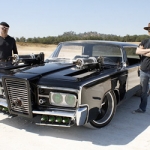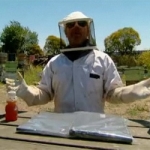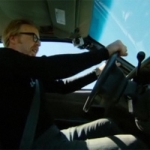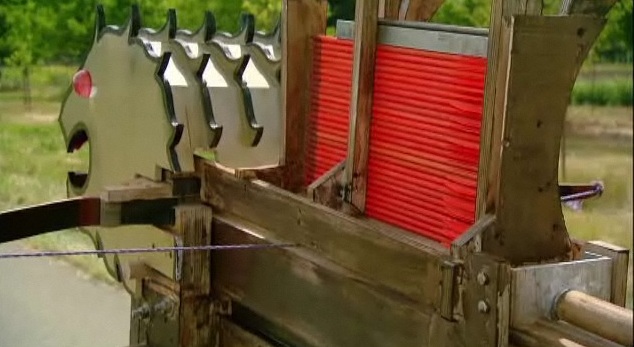
Episode: Mythbusters 8.22 – “Arrow Machine Gun”
Original Air Date: November 3, 2010
Building ancient weapons that may or may not have actually existed? Check. Use of alcohol in the name of science? Check. Shooting at something? Check. Driving cars in dangerous conditions? Check. Adam in a silly costume? Check. Rocket-propelled rodents? Check. Grant-created electronics? Check. Explosions? Well, no, actually, that’s the one thing on the Mythbusters’ checklist that this myth does not have. It’s still an action-packed episode, though; Adam and Jamie tackle the question of whether or not the ancient Greeks could have had a machine that fires arrows rapidly and accurately while Kari, Grant and Tory find out the extent to which sleep deprivation impairs a person’s driving compared to alcohol consumption. Ready for a wild ride? Thought so! Hang on, then, and keep reading (unless, of course, you haven’t seen the episode yet and wish to remain unspoiled, in which case you should exit the car carefully and have a seat over there).
Myth 1: The ancient Greeks had a weapon that mechanically fired arrows.
Mythbusters: Adam and Jamie
Procedure:
1. Build a machine like the one the ancient Greeks could have built, with the following criteria drawn from the historical record:
- It must have a range of 200 yards/600 feet.
- It must be able to shoot at a rate of five arrows per minute.
- It must be accurate enough to hit a human-sized target.
2. Take the machine to a large, open, outdoor space to test it to determine whether or not it falls within the above parameters.
3. Return to the shop for a few modifications based on the results of the first field test.
4. Record data related to range, speed, and accuracy of a human archer for later comparison to the machine.
5. Use the machine to fire arrows at five inflatable figures until all have been hit and record the time and number of arrows it takes to bring down all five “enemies.”
Results: In the first round of field testing, the Mythbusters discovered that the machine had a range of 690 feet, which was pretty darn close to what they were trying to get. Speed and accuracy were still a problem, though — the mechanism did not work reliably and consistently, and it was both inaccurate and difficult to aim. The machine went back to the shop for some modifications, most notably a set of wheels and an angle finder to make aiming it easier. Jamie also modified the handle used to crank the gears that drive the machinery to make it easier to turn smoothly.
Since the point of this machine is to fire arrows faster and better than human archers, the second field test began with the gathering of some control data from the highest-ranked archer in the United States, Brady Ellison. He was able to hit all five targets 200 yards away in two minutes, using 11 arrows. Then, it was the machine’s turn to perform, which it did for a while until it got jammed up and stopped working. Again. And again. And…you get the picture. I loved Jamie’s comment: “Sooner or later we’re gonna run out of things to go wrong and then it’ll work great!” Finally they were able to get it working again and downed all five targets in 1 minute 50 seconds, using 15 arrows.
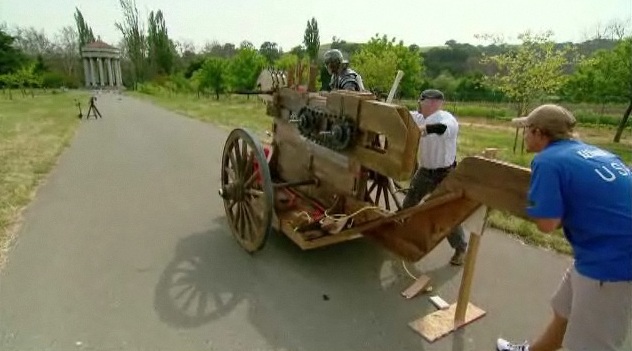
Conclusion: Ellison’s rate of fire was 5.5 arrows/minute, while the machine fired 8 arrows/minute. Despite using more arrows than Ellison (which would mean that the machine is slightly less accurate than a human archer), it was accurate enough to down the five targets faster than Ellison. Based on these results, which actually exceeded the stated parameters, Adam and Jamie declared the myth to be plausible.
Myth 2: Driving tired is more dangerous than driving tipsy.
Mythbusters: Kari, Grant, and Tory
Procedure:
1. Visit a sleep lab to learn about the effects of sleepiness on the brain (there is less brain activity when a person is sleepy than when he or she is fully awake and alert). Learn from the expert that monotonous highway driving is likely to be much more dangerous when sleepy than city driving.
2. Go to a local law enforcement training center and create two driving courses. One will be an obstacle course involving steering around cones, paying attention to traffic signs and signals, parallel parking, and avoiding a large fake rat propelled suddenly and unexpectedly into the car’s path. The other will be a simple loop around which the drivers will drive 25 laps while trying to stay between the two white lines marking the traffic lane.
3. Drink enough alcohol, based on body weight, to become tipsy but still register below the legal limit when given a breathalyzer test.
4. Drive the two courses, monitored by a team member and law enforcement trainer to determine number of mistakes made in the obstacle course and the number of times the car drifted over the line in the monotonous driving course. The length of time the car remains over the line will also be measured, with the help of Grant’s fancy electronics attached to the car.
5. After an appropriate recovery time, prepare for the second test by staying up all night, using a variety of stimuli to stay awake, including watching movies, exercising on a treadmill, playing ping-pong, and other shenanigans.
6. Repeat step four and compare the results of the two tests.
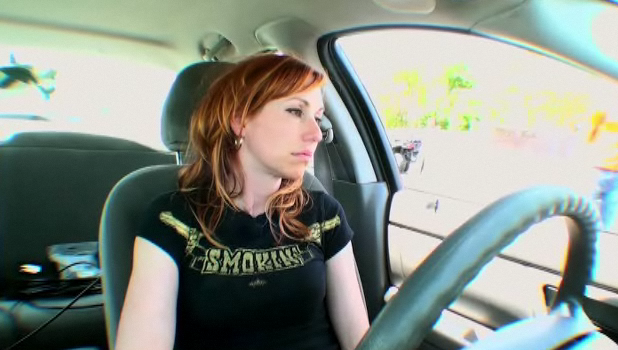
Results: Kari and Tory were the victims, I mean test subjects, for this myth, while Grant was responsible for monitoring the test and collecting the data. When driving tipsy, Kari made seven mistakes on the obstacle course and drifted over the line in the monotonous course 104 times with a total time of 58 seconds over the line. Tory made only two mistakes on the obstacle course (including hitting the rat) and crossed the line only four times, staying outside his lane for only 1 second. After staying up all night, Kari made 6 mistakes on the obstacle course and strayed off the monotonous course twice as often as before, 210 times, spending a total of 332 seconds (5 and a half minutes) over the line. Tory made five mistakes on the obstacle course and left his lane 110 times on the monotonous course, staying over the line for a total of 77 seconds.
Conclusion: Both Kari and Tory scored much worse on the two driving tests, particularly the monotonous one, when sleep-deprived than when tipsy. Myth Confirmed: lack of sleep causes as much if not more impairment than the amount of alcohol needed to make someone tipsy. We are reminded several times, though, that driving tipsy (i.e., just under the legal limit for blood alcohol level) is still never a good idea, either, even though technically it is legal. Don’t drink and drive, Mythbusters fans!

Overall I found this to be an enjoyable episode, even though I had a few points of contention with the myths, as well as with Adam’s repeated use of the descriptor “Ye Olde” (pronouncing it like “oldie,” of course). Once is kinda funny, more than that is really annoying, but I digress. I always wonder about the myths that involve ancient weaponry of which we have few written records and no archeological evidence — if it really existed, wouldn’t we know more about it? Still, I was impressed at their ingenuity and creative ability, not to mention the fact that it actually worked, unlike many of the mythological weapons they have tried before (the Archimedes Death Ray and the Confederate Rocket come to mind).
As for the second myth, it was a real eye-opener, so to speak. I would love to see a re-visit of this myth where they see if caffeine makes them more alert and less impaired when driving sleep-deprived — one thing they specifically stated was that they avoided caffeine and other stimulants for this test, which must account for the fact that Kari and Tory looked much more sleepy at 9:00 am after being up for over 24 hours than I ever felt on the handful of occasions as an undergraduate and grad student when I pulled an all-nighter to finish an assignment. I also wondered why they had no control test where they drove the two courses awake and sober, and if you thought the same, head on over to Discovery.com where Kari, Grant, and Tory address this and several other questions in their after-show video clip. Other highlights of the video playlist are Adam and Jamie’s after-show video and a guided tour of the driving obstacle course that didn’t make it into the episode. You can skip the clips from the high-speed camera this week, though — the arrow machine gun just doesn’t have enough visible moving parts to make it interesting.
Rating: 4 / 5 Stars



